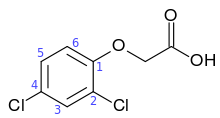Defoliant


A defoliant is any herbicidal chemical sprayed or dusted on plants to cause their leaves to fall off. Two of the oldest chemical herbicides used as defoliants are 2,4-Dichlorophenoxyacetic acid (2,4-D) and 2,4,5-Trichlorophenoxyacetic acid (2,4,5-T). 2,4-D and 2,4,5-T are absorbed by the leaves of plants, killing them by causing excessive hormonal growth.[1] Defoliants are widely used for the selective removal of weeds in managing croplands and lawns. Such use worldwide, along with the development of other herbicides and pesticides, allowed for an increase in agricultural production around the mid-20th Century during what was called the Green Revolution.[1] Defoliants have also been sometimes used in warfare as a means to deprive an enemy of food crops and/or hiding cover.
History
A classic example of a highly toxic defoliant is Agent Orange, which the British military used abundantly to defoliate regions of Malaya starting in the early 1950s during the Malayan Emergency of 1948–60, and the U.S. military to defoliate regions of Vietnam from 1961 to 1971 during the Vietnam War of 1955–75.[2][3]
Uses
Defoliants differ from herbicides in that the former seek mainly to strip leaves from plants, but the latter are used to destroy or inhibit the growth of certain plants.
Defoliants are used in cotton production to aid harvesting.[4]
See also
References
- 1 2 Zierlier, David (2011). Invention of Ecocide. Athens, GA: University of Georgia Press. ISBN 9786613110404.
- ↑ Tow Fawthrop (June 14, 2004). "Vietnam's war against Agent Orange". bbc.co.uk.
- ↑ "Agent Orange Linked To Skin Cancer Risk". Science 2.0. Retrieved 17 September 2014.
- ↑ Gwathmey, C.O.; Craig Jr., C.C. (2007). "Defoliants for cotton". In David Pimentel. Encyclopedia of Pest Management. 2. CRC Press. p. 135. ISBN 1-4200-5361-2.
External links
| Wikimedia Commons has media related to Defoliants. |
- Defoliants and Desiccants by Frederick M Fishel, Pesticide Information Office, Institute of Food and Agricultural Sciences, University of Florida